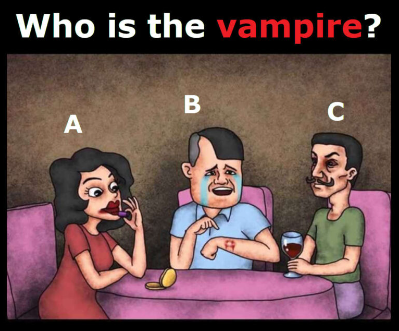Welcome to another captivating brain teaser that’s been puzzling minds across the internet! Today, we’re diving into a particularly intriguing challenge: “Who is the vampire?” If you’re up for a test of your deductive skills, take a moment to analyze the image before reading ahead. Look closely at the individuals depicted and see if you can figure out who among them might be hiding a dark, supernatural secret.
As with many visual puzzles, the thrill comes from piecing together subtle clues to uncover the truth. However, many puzzle enthusiasts fall into the trap of focusing on the obvious—like facial expressions or attire—and miss the crucial details that reveal the true answer. Let’s break down this challenge step by step and uncover who the real vampire is.

When tackling visual puzzles, it’s easy to get distracted by surface-level details. In this particular vampire-themed puzzle, the goal is to identify which of the three individuals is the vampire. But beware! The answer isn’t as simple as picking the person who looks the most sinister or mysterious. The real solution lies in subtle, easily overlooked clues.
Focusing too much on facial expressions, posture, or attire can mislead even the most observant puzzle solvers. Instead, solving this puzzle requires a sharp eye for detail and a closer look at the characters’ interactions with their surroundings. The key to success? Focus on the elements that play into classic vampire folklore.
Step One: Examine the Reflections in the Mirror
In this puzzle, the setting provides an essential clue—the mirror. Mirrors have long been linked with vampire lore, and this puzzle is no exception. In traditional folklore, vampires are unable to cast reflections in mirrors, making this detail critical in determining the vampire’s identity.
As you look at the image, pay close attention to each character’s reflection in the mirror. Is there anything odd or out of place? You might notice that while most characters have clear reflections, there is one striking exception.
Step Two: Analyze Each Character’s Actions
Each of the three individuals is engaged in a distinct activity: one is eating, another is drinking, and the third is applying lipstick. These actions aren’t random. They’ve been chosen deliberately to provide subtle clues about the characters’ identities.
Let’s start with the individual applying lipstick—character “A.” Her behavior and how she interacts with her reflection, or lack thereof, holds the key to solving this puzzle. Watch closely as she applies the lipstick. Is something unusual about her technique? Is the lipstick applied messily or inaccurately?
Step Three: Identify the Key Detail
At first glance, the lipstick application might seem like an ordinary activity. But upon closer inspection, you’ll notice that character “A” is having trouble applying it neatly. Her lipstick is smudged and uneven. This detail might seem minor, but it’s incredibly revealing.
Why would she be struggling with something as simple as applying lipstick? The answer is clear: she can’t see her reflection in the mirror. Vampires, according to legend, don’t cast reflections, and that’s why her makeup application is clumsy and off.
The Mirror Holds the Answer
The mirror in the background serves as the final piece of the puzzle. While the other characters have visible reflections, character “A” has none. Her inability to see herself is the ultimate clue that she’s the vampire. This is a clever use of one of the most classic vampire tropes—lack of reflection—hidden in plain sight.
Step Four: The Answer Revealed
So, after carefully analyzing the visual cues and folklore references, the answer is clear: the vampire is character A. Her inability to cast a reflection, as seen when she struggles to apply her lipstick, gives her away. The puzzle cleverly tests your ability to observe small but significant details, using a well-known aspect of vampire mythology to craft a compelling challenge.

What makes this brain teaser particularly engaging is its reliance on classic vampire lore mixed with visual trickery. By making you focus on the actions and surroundings of the characters, the puzzle encourages you to think critically rather than jump to conclusions based on appearance alone.
Puzzles like this challenge your ability to pay attention to the smallest of details, reinforcing the importance of observation and patience. It’s not just about seeing what’s in front of you, but understanding the significance of the elements within the image.
So, did you guess correctly, or were you surprised by the solution? Whether you spotted the vampire right away or were misled by the other clues, this puzzle offers a fun way to test your observational skills. Character “A” and her missing reflection were the key to unlocking the mystery, a testament to how small details can make all the difference.
If you enjoy puzzles like this, keep challenging yourself. There are countless riddles and brain teasers out there that test different aspects of thinking, from logic puzzles to visual illusions. By practicing with puzzles like this, you can continue to hone your attention to detail and problem-solving skills.
Next time you encounter a tricky puzzle, remember to slow down, look closely, and consider every clue. You never know what mysteries you might uncover with just a bit of critical thinking and a sharp eye. Happy puzzling!